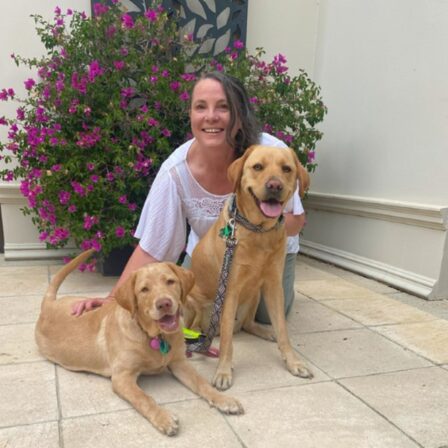News
Dog separation anxiety and how to treat it

Most dogs and animals, including humans, will experience an element of anxiety from time-to-time when it comes to saying goodbye to their favourite friends. But how much is too much when it comes to separation anxiety?
Guide Dogs Victoria uses Positive Reinforcement Training (PRT) to train well-bonded, reliable Guide Dogs who enjoy learning. By promoting best practice in their care and training, we can ensure our pups grow up to be comfortable in whatever environment their home is likely to be.
Your PAWfect little pal will learn a little differently to our pups in training. Find out how to identify and treat dog separation anxiety in your pet with Guide Dogs Victoria.
What is dog separation anxiety?
Separation anxiety in dogs is a natural response to the fear of being alone. Generally, this fear is triggered when the person a dog is most attached to leaves. While some dogs will find lots of ways to stay entertained when their owner is out and about, others simply get distressed.
Causes of dog separation anxiety
- being left alone when used to constant companionship
- being alone for the first time
- moving house
- traumatic experiences
- change of ownership or a birth or death in the family
- changes to routines and schedules, for example, the rise of working from home during the pandemic.
Identifying dog separation anxiety
Separation anxiety in dogs can present in many ways. These coping mechanisms are usually not observed when in the company of their owner or favourite person.
Common symptoms of dog separation anxiety:
- barking or howling
- whining, whimpering or ‘crying’
- destructive behaviour (chewing or destroying furniture near exits and windows)
- toileting accidents, although they are house trained
- signs of anxiety while you prepare to leave
- clear relief when you return home.
Less common symptoms of dog separation anxiety that you might miss:
- drooling or excessive salivating
- chewing at body parts such as feet and tail
- trembling or panting
- repetitive behaviours such as pacing or excessive barking
- vomiting
- not eating meals while you’re out.
If your dog has been destructive when left alone, never punish them when you arrive back. This will only increase anxiety around you returning, as well as you leaving.
How to treat separation anxiety in dogs
Being such a social species, separation can feel unnatural and harder to handle for dogs. Once you have noticed signs of anxiety, treat the dog as soon as possible to prevent their stress from getting worse over time.
Start by associating the experience with something positive – like treats! PRT and patience will gain better results.
Tips to make separation anxiety in dogs easier
- Avoid making a fuss when leaving or coming home.
- Take a morning walk and wear out your dog before heading out for the day to help them relax and rest.
- Provide mental stimulation using interactive and enriching toys to keep them entertained.
- Leave some curtains open so they can stay entertained and explore with their eyes while you’re away.
- Teach your dog that the ‘cues’ for you leaving don’t always mean you’ll leave. Pick up your keys and simply put them in your pocket. Put on your coat and shoes and sit down.
- If you’re really worried about your canine companion, ask an available friend or family member to pop in and check on them during the day.
Dog separation anxiety training
- Encourage the dog to go to their bed and spend a moment there with them. Give them a reward for staying cute and quiet.
- Now, get them to stay on the bed as you slowly move away. When you return to the bed, calmly reward them for staying put.
- Continue to return and reward, each time increasing the distance and length of time you’re away for. Don’t reward them when they react and never punish – just go back to the start.
- Once the dog is comfortable with this, start the process again, this time leaving the room and closing the door for longer periods each time.
- Your dog will soon become comfortable being left alone for up to an hour. Once they reach this point, you shouldn’t have any issues leaving home for longer.
If the problem persists, consult your vet regarding other approaches. Dogs with true separation anxiety may need other solutions to address their anxiety.
Want to find out how our dogs make a difference? Learn more about our Guide Dogs and their work in the community.
Want to find out how you can make a difference? There are heaps of ways you can get involved with Guide Dogs Victoria!







